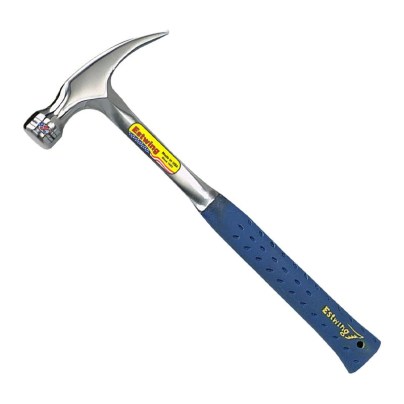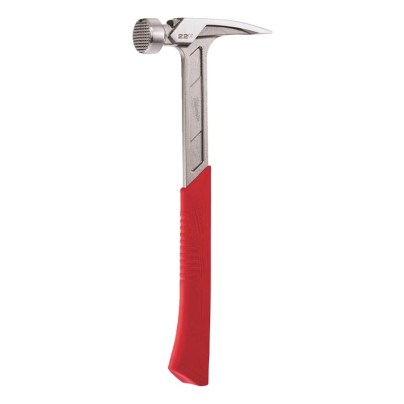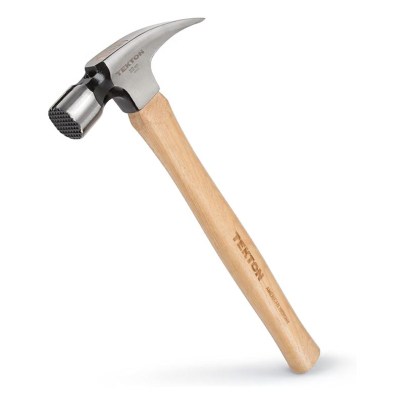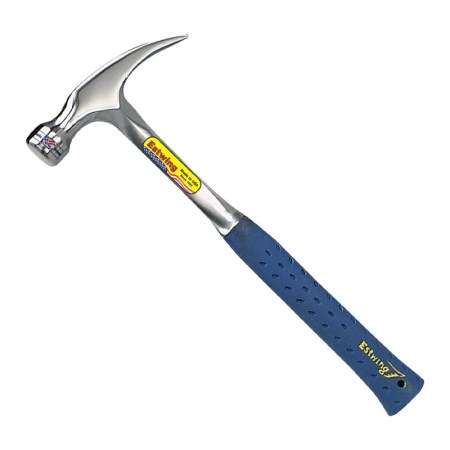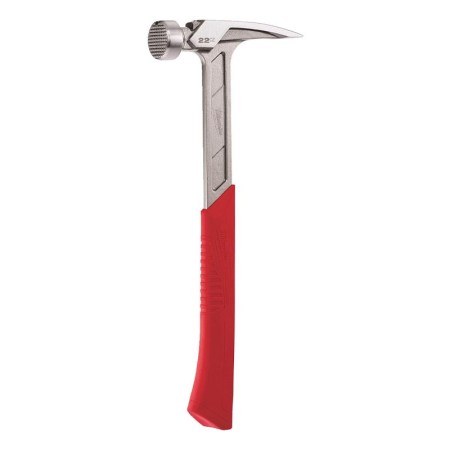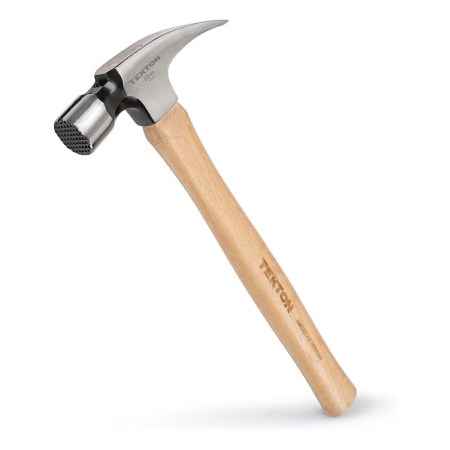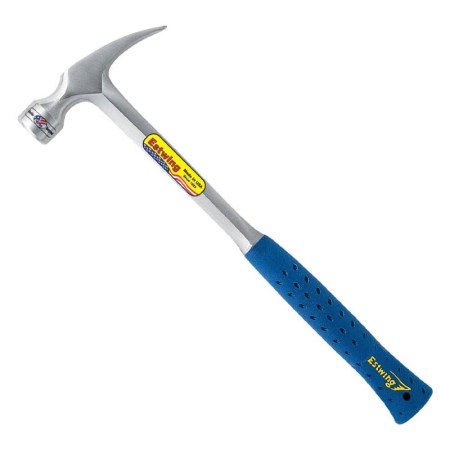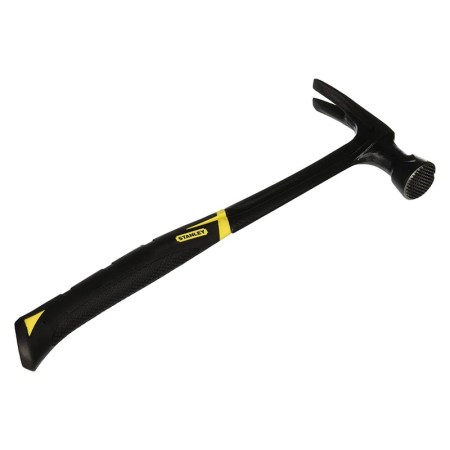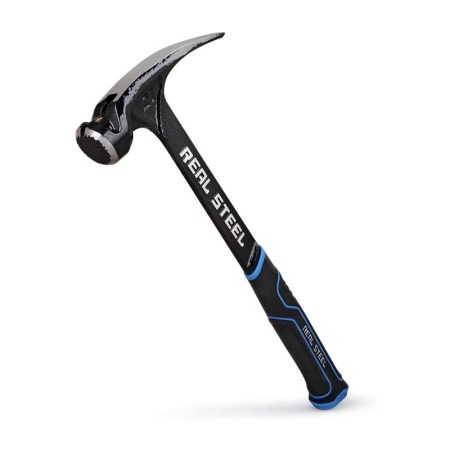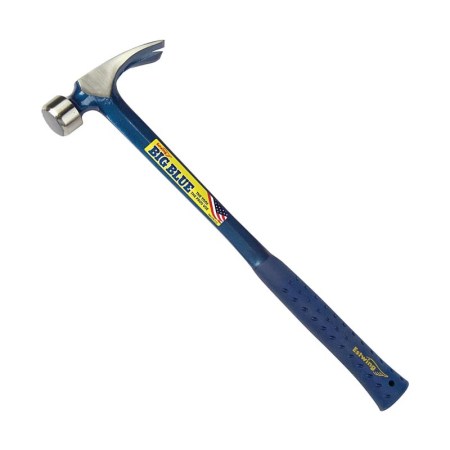We may earn revenue from the products available on this page and participate in affiliate programs. Learn More ›
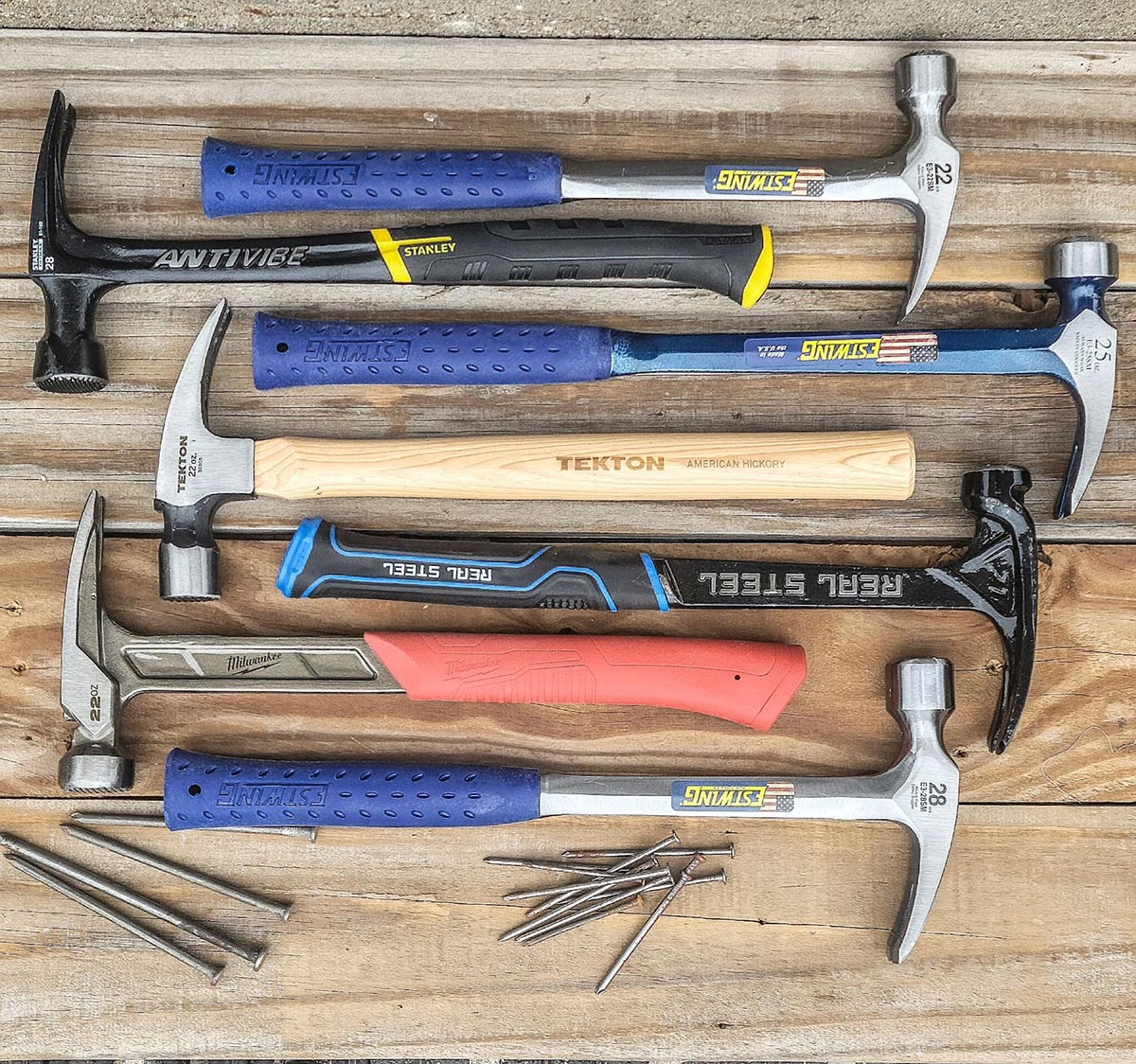
A standard household hammer—weighing an average of 12 to 15 ounces—is indispensable for simple tasks like tapping a nail into a wall to hang a piece of artwork. But it’s not the best choice for erecting the skeletal structure of a home, garage, or other building—a task known as “framing.” When it comes to assembling wall studs, floor joists, and rafters, reach for a framing hammer.
These specialized tools look like traditional hammers for the most part, although the claw in back is straighter and elongated as opposed to curved. But the biggest difference is in weight. In many cases, a framing hammer is literally a heavy hitter, weighing more than a household hammer—up to 2 pounds more, in fact. This extra weight provides the power needed to drive the long nails used in framing.
We wanted to know more about the top contenders in the framing hammer market, so we tested them. We drove large framing nails while noting handle vibration, grip comfort, and overall balance. We pulled out nails using the hammers’ pry bar-like claws and even used the claws for a bit of demolition work. We rated each hammer’s performance in multiple categories to give our readers a good idea of the pros and cons of each model.
Whether you’re a carpenter or a DIYer, if you’re going to frame a building, you’ll want a hammer designed for the job. Keep reading to learn what to look for when shopping for the best framing hammer and find out how the following hammers earned a spot on this lineup.
- BEST OVERALL: Estwing 22 Oz.Milled-Face Framing Hammer
- RUNNER-UP: Milwaukee 22 Oz. Milled-Face Framing Hammer
- BEST BANG FOR THE BUCK: Tekton 22 Oz. Magnetic-Head Framing Hammer
- UPGRADE PICK: Estwing 28 Oz. Milled-Face Framing Hammer
- BEST ANTI-VIBE GRIP: Stanley 28 Oz. FatMax AntiVibe Framing Hammer
- BEST LIGHTWEIGHT: Real Steel 0517 21 Oz. Ultra Framing Hammer
- ALSO CONSIDER: Estwing 25 Oz. Big Blue Pro Line Framing Hammer
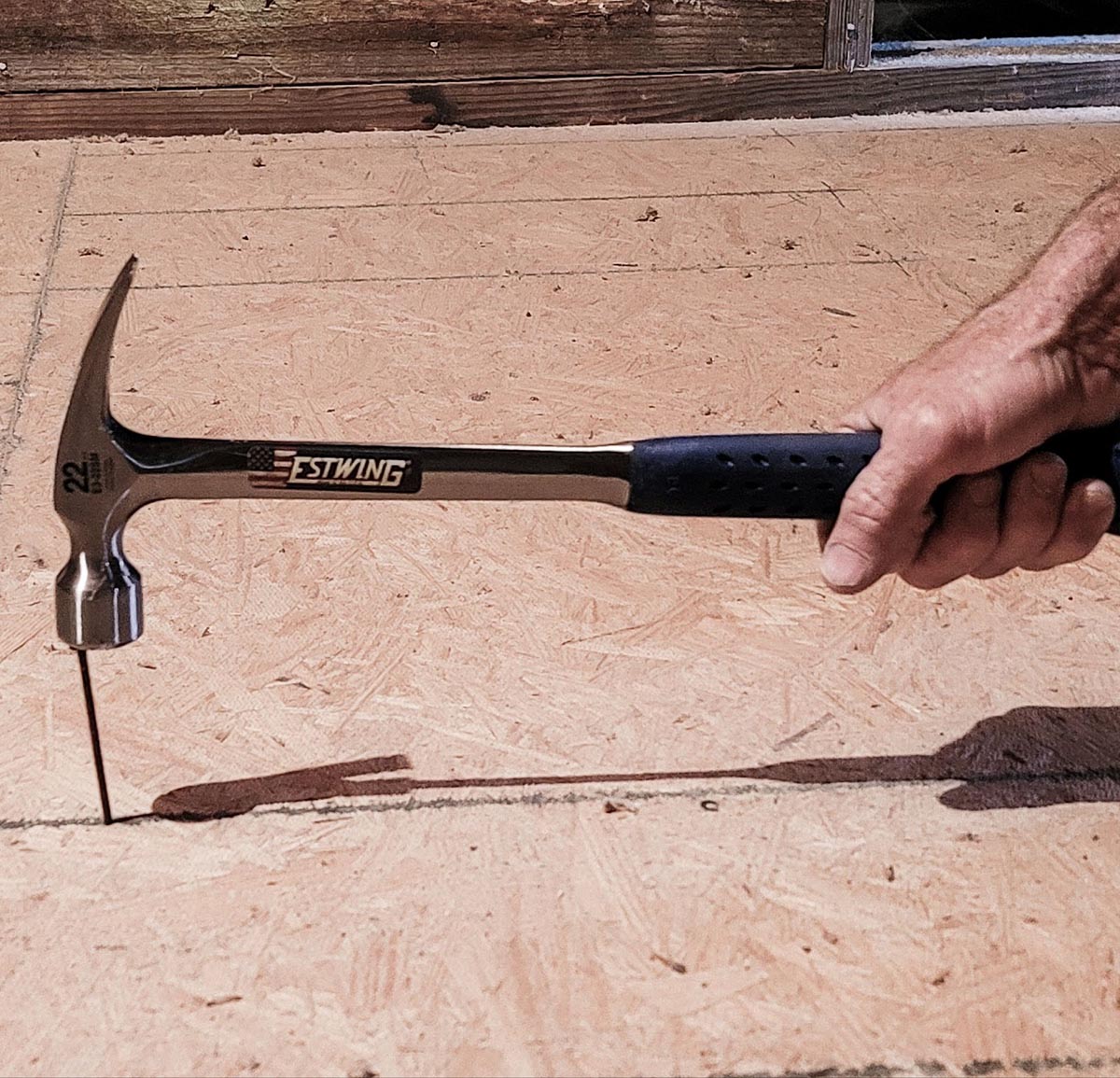
What to Consider When Choosing the Best Framing Hammer
Large nails (16-d or 16-penny) are often used to construct the frame of a building, so the best framing hammer should be substantial enough for the user to sink the nails into the wood in as few swings as possible. It’s not unusual for construction professionals to drive a single large nail in as few as three or four swings. When shopping for a framing hammer, consider its weight, ability to reduce arm and hand fatigue, and whether it’s intended for beginner or professional use.
Head Weight
A hammer is designated by the weight of its head, and the best framing hammer should be heavy enough to generate a powerful blow with each swing. In general, the heavier the head, the more power that can be generated with a single swing, but if users are not seasoned pros accustomed to wielding a hammer on a daily basis, a heavier model could leave their arms, hands, and wrists feeling sore. When choosing a head weight, shoppers should be honest about their experience level and physical ability.
Most framing hammers have steel heads that weigh between 20 and 32 ounces, although a few heavier and lighter ones are available. Framing hammers made from titanium, a hard but lightweight metal, weigh only between 15 and 19 ounces. They don’t transmit as much vibration as steel—a plus for users bothered by the shock of impact experienced with steel. However, titanium is expensive. Steel framing hammers cost less than $50, but one made from titanium can easily run over $200.
Handle Material
Hardwood is the traditional material used in hammer handles, and many pros still prefer it, claiming the wood absorbs most of the impact shock that would otherwise end up in the builder’s elbow and arm. Solid-steel handles, forged along with the head in a single piece (called “full tang”), are also popular, especially with experienced builders who want a hammer that will last for years. Steel doesn’t offer as much vibration reduction, so full-tang steel hammers are well suited to pros who rarely miss the nail when they swing. Steel handles with fiberglass or a rubber coating offer a measure of vibration reduction while providing nonslip grip control.
Face Type and Claw
Framing hammers come with two types of faces for striking nail heads: textured (also known as waffle) faces and smooth faces. Many framers opt for a textured face because the rough surface helps keep the hammerhead from glancing off the nail, which makes for better strike contact. On the downside, if builders miss the nail, a waffle face will leave a deep textured impression in the wood. In addition, the rough texture may do more damage if users smash a finger, although hitting a finger with any hammerhead is going to hurt.
A common saying in the construction industry is that by the time new builders wear the waffle texture off the face of a framing hammer, they’ll be adept enough at driving nails to use a smooth face going forward. However, all the framing hammers that made our roundup have milled waffled faces.
On the opposite end of the head is the claw or rip claw, which is elongated as opposed to the curved shape of a traditional hammer. The user can pull nails with the claw or use it as a crowbar for prying boards apart; it can also function as an axe for striking plywood and pulling boards off a structure during demolition.
Tang
Many tools, not just knives, have tangs—the steel components that connect the business end to the handle. On a framing hammer, the tang is the molded-steel handle that’s forged to the hammerhead in a single piece. Many of today’s framing hammers feature a partial tang (only a portion of the steel extends down into the handle). Partial-tang hammers tend to be a few ounces lighter, so builders looking for a heavier hammer may prefer one with a full tang.
With a full tang, the steel extends all the way to the bottom of the handle. Full-tang hammers are less likely to break during use because of the rigid support that goes all the way through the handle, yet some users complain that full-tang hammers have greater impact vibration. Manufacturers rarely mention tang in their product description unless the hammer features a full tang.
The hammerhead on wood hammers has no tang; instead, the wood handle extends upward and is secured within the hammerhead itself.
Magnetic Nail Set
During the framing process, builders must often insert nails overhead—and it can be challenging to hold a nail with one hand while tapping it with the hammer to start insertion before swinging with full force. That’s the main reason why some newer framing hammers come with a magnetic nail set on the top of the hammerhead. By placing a nail in the nail set, the user can simply tap the wood to insert the nail. After the first tap, the nail sticks in the wood, and then the user can swing the hammer full force to sink it. Pros don’t always use a magnetic nail set; they often find it faster to start the nail traditionally by holding it in place for the first tap. However, DIYers and those new to framing may find the feature valuable for starting nails and preventing smashed fingers.
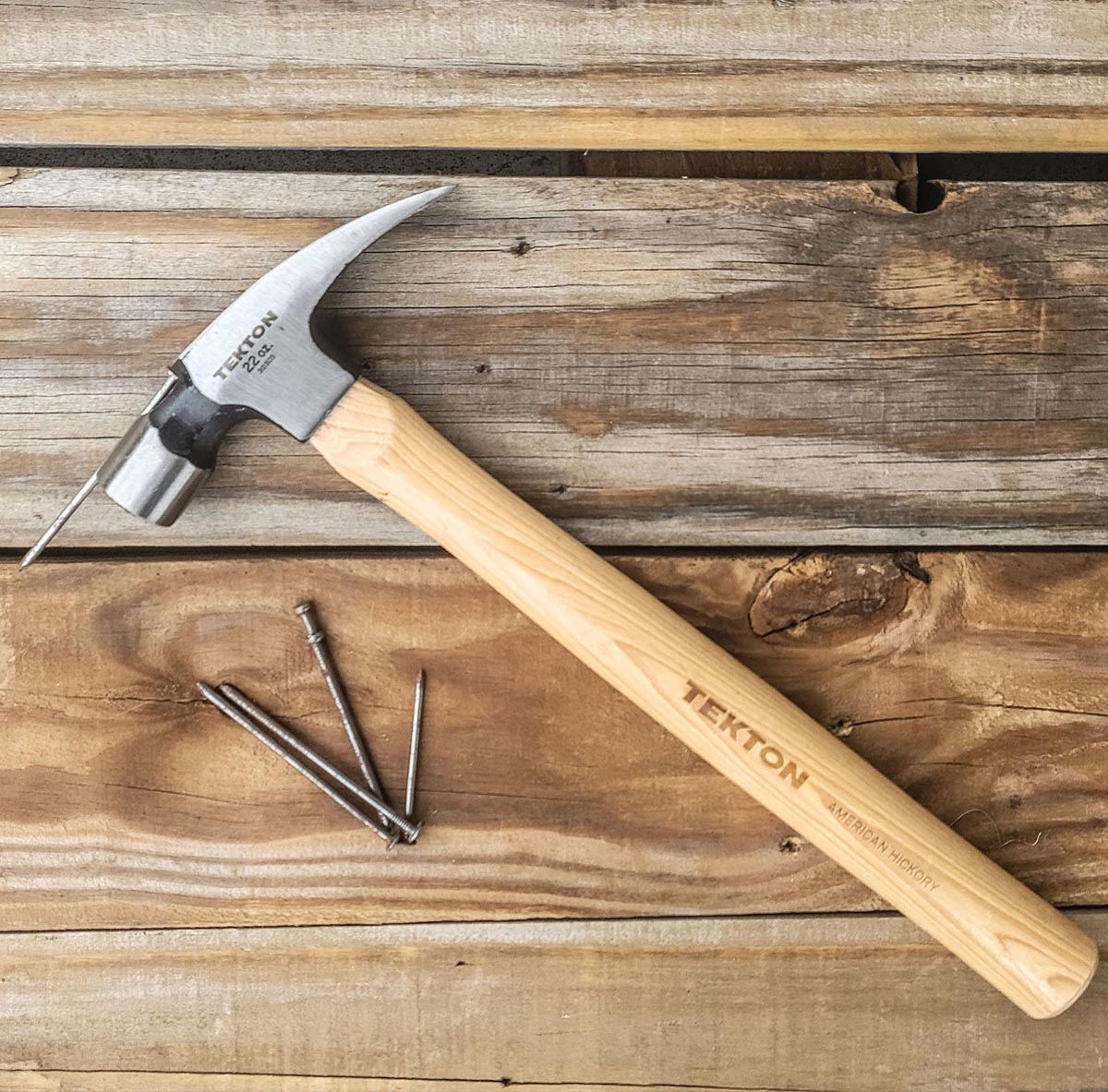
Our Top Picks
The best framing hammer is sturdy, reliable, and comfortable to swing, and those were the primary qualities we looked for as we put the models reviewed here through their paces. These top picks represent not only the hammers that are the most popular with professional framers but also those that excelled in our hands-on tests. They vary in materials and weight, but each proved itself in testing.
When it comes to framing hammers, the Estwing Manufacturing Co. reigns supreme. The company has been producing high-quality hammers for nearly a century, and our top pick in this lineup is a favorite pick of builders everywhere. This Estwing framing hammer comes with virtually everything needed to construct a structural frame. Not only did this hammer excel in our hands-on testing, but it’s also a long-time favorite of ours for all types of framing, such as setting walls, installing subflooring, and setting roof trusses.
The framing hammer weighs in at 22 ounces. That’s not as heavy as some of the other framing hammers in this lineup, but it’s beefy enough to generate powerful nailing force without being so heavy it exhausts the user after 15 or 20 minutes of continuous nail driving. The Estwing hammer measures 15.75 inches from the top of the head to the tip of the handle, and we feel that’s an optimal length for framing purposes. This is a full-tang hammer; the steel runs all the way from the hammerhead to the tip of the handle.
We drove 16-d framing nails (3.5 inches long) into 2×4 dimensional lumber boards and through subflooring panels attached to 2×10 floor joists with this framing hammer, and it performed flawlessly. We appreciated its padded nonslip grip that reduced impact vibration, and we found the milled waffle face made it easy to hit the nailheads without the hammer deflecting to one side. We used the claw end to rip through old plywood sheeting and pull it off.
Another benefit that might not be immediately noticeable is Estwing’s symmetrical handle design. The handle is comfortable to hold, but the most significant benefit is that it fits in hand the same way when nailing as when pulling nails or using the claw for demo purposes. Hammers with ergonomic handles can sometimes feel awkward when the hammer is turned around for pulling nails. The symmetrical handle is a standard feature on Estwing hammers, and for pros, that sets them apart.
Product Specs
- Weight: 22 ounces
- Handle type: Full tang; nonslip symmetrical handle
- Face: Milled (waffle)
Pros
- Well-balanced
- Vibration-reduction padded grip
- Symmetrical handle
- High-quality construction
Cons
- Pricey
Get the Estwing 22-oz. framing hammer at Amazon, The Home Depot, or Lowe’s.
The Milwaukee Milled-Face Framing Hammer comes from another manufacturer that is well-known for its quality hand and power tools. It’s designed with the DIYer in mind but is also suitable for pros.
Weighing in at 22 ounces, the Milwaukee framing hammer proved to be heavy enough to generate swing force without causing undue wrist and arm fatigue. It comes with a magnetic nail set that holds a nail in place for the first tap, and it features an ergonomic nonslip grip that we found very comfortable for nailing. When we turned the hammer around for pulling nails, however, the grip felt slightly awkward. We did notice that the rubberized grip absorbed a good deal of vibration when nailing.
This Milwaukee model is a full-tang framing hammer that measures 15-1/16 inches from the top of the head to the tip of the handle. The claw is very straight, which makes it well suited for demolition purposes (think of using it like an axe to rip through old plywood). It’s a darned good and durable hammer made to withstand years of dependable use.
Product Specs
- Weight: 22 ounces
- Handle type: Full tang; nonslip ergonomic handle
- Face: Milled (waffle)
Pros
- Well-balanced
- Magnetic nail set
- Nonslip grip
- Anti-shock rubber
Cons
- Grip feels awkward when held backwards for pulling nails
Get the Milwaukee framing hammer at The Home Depot or Ohio Power Tool.
The Tekton magnetic framing hammer offers the same waffle face found on pricier models, and at 22 ounces, it provides adequate weight for generating powerful nail-driving swings. It also boasts a slightly contoured claw that we found useful for pulling nails and ripping plywood.
It features a magnetic nail holder for those beginners not yet comfortable holding a nail with their fingers for the first swing. We were particularly impressed with this feature, since the magnet on the nail set of some hammers isn’t strong enough to hold the nail securely, allowing it to fall off. Not so with the Tekton—its magnet seemed especially strong and held the nail snugly until the first tap embedded it in the board.
The most significant difference with the Tekton framing hammer is its hickory wood handle. Wood handles have long been preferred by those who want maximum vibration reduction, and the Tekton does not disappoint in that sense. We found it very comfortable to use and didn’t notice any uncomfortable nailing vibration.
The downside—and this is just a matter of personal taste—is that the hammer has no tang. The steel head is only a head, and the point where the handle connects to the head is a weak spot. Throughout our testing, the handle on the Tekton held firm, but we’ve used many wood-handle hammers in the past and have had to replace handles because they broke near the head. The upside is that the handle is replaceable, so for those who prefer the low vibration and smooth feel of natural wood, the Tekton is a winner. Best of all, it’s a good framing hammer at an affordable price point.
Product Specs
- Weight: 22 ounces
- Handle type: No tang, hickory wood handle (replaceable)
- Face: Milled (waffle)
Pros
- Very little vibration from strikes
- Symmetrical handle
- Smooth wooden grip
- Magnetic nail set
Cons
- Wood handles tend to break with heavy use
Get the Tekton framing hammer at Amazon or Lowe’s.
The second Estwing in our lineup of the best framing hammers weighs a hefty 28 ounces, so it’s not for the faint of heart. This framing hammer comes with all the high-quality features found on other Estwing hammers, including a symmetrical grip that feels the same in hand whether the user is hammering or removing nails.
The extra few ounces can make it challenging for a framing novice to control without swinging wildly. However, for users familiar with driving framing nails—and who have the arm strength to do so with ease—this Estwing framing hammer will make quick work of the framing process.
There’s no magnetic nail set on this hammer, which makes it a better choice for experienced users versus newbies. We found this heavier Estwing to be well-balanced, and we didn’t feel a lot of uncomfortable vibration, thanks to its anti-shock nonslip grip. This bad boy measures 16 inches from the top of the head to the end of the handle. It comes with a full tang to provide years of durable service, and its waffle face helps keep the hammer from deflecting when it strikes the nails.
This 28-ounce Estwing is among the top framing hammers for pros, but we feel it’s slightly on the heavy side for those who are just getting into framing.
Product Specs
- Weight: 28 ounces
- Handle type: Full tang; nonslip symmetrical handle
- Face: Milled (waffle)
Pros
- Maximum swing force for nailing
- Anti-shock grip
- Symmetrical handle grip
- Full tang for durability
Cons
- On the heavy side
Get the Estwing 28-oz. framing hammer at Amazon, The Home Depot, or Lowe’s.
Those looking for a beefy, full-tang framing hammer that doesn’t generate a lot of unwanted vibration may want to consider the Stanley FatMax AntiVibe framing hammer.
This is a heavy-duty full-tang hammer, but at 28 ounces, we still found it well-balanced and unusually easy on the wrist and arm. The manufacturer claims the anti-vibration benefit results from a unique design within the steel itself. We can’t speak to that, but we can say that we were pleasantly surprised at how little vibration transferred through the hammer to our wrists and arms.
The FatMax AntiVibe framing hammer also boasts a larger strike face, which is a nice feature for those who have a bit of trouble hitting the nail on the head. A standard framing hammer face measures about 1 to 1.25 inches in diameter, while the Stanley strike face is fully 1.5 inches in diameter for fewer misses when nailing. The hammer measures 15.25 inches from end to end.
The hammer has a magnetic nail set, but we found the magnet to be slightly on the wimpy side. When we placed nails heavier than 16-d nails, such as 7-inch ring-shank nails, they’d often fall off before we could tap the wood and start the nail. The claw has a slight curve and worked well for pulling nails and demolition.
The padded nonslip grip on this framing hammer is exceptionally comfortable when nailing, but it didn’t feel great in hand when we turned the hammer around to pull nails and rip plywood. Despite a few minor issues, we can recommend this model to those looking for a heavy framing hammer with minimal vibration.
Product Specs
- Weight: 28 ounces
- Handle type: Full tang; ergonomic padded grip
- Face: Oversize milled (waffle)
Pros
- Oversize face for nailing
- Comfortable ergonomic grip
- Anti-vibration
Cons
- Handle not comfortable for pulling nails
- On the heavy side
- Magnet slightly weak in nail set
Get the Stanley framing hammer at The Home Depot or Stanley.
Tipping the scales at just 21 ounces, the Real Steel 0517 Ultra Framing Hammer is the lightest-weight model in our lineup, but it still performs well for framing, nail pulling, and demolition. This full-tang framing hammer has a waffle face and a magnetic nail set, making it suitable for DIYers learning to frame. We found it comfortable to hold when driving nails, although it transfers more vibration than our other picks, and its ergonomic handle isn’t as comfortable to hold when the hammer is turned around to pull nails.
The magnetic nail set is quite good at holding the nails for the first tap—the magnet seemed nice and strong—and the rubber on the grip kept our hands from slipping. We liked the lighter weight of the Real Steel framing hammer, and at 15.5 inches, it’s a handy length for most users. However, we feel it’s best suited to limited framing since the vibration could become uncomfortable if framing for hours straight.
Product Specs
- Weight: 21 ounces
- Handle type: Full tang; rubberized ergonomic grip
- Face: Milled (waffle)
Pros
- Lighter weight
- Magnetic nail set
- Full tang for durability
Cons
- Ergonomic handle uncomfortable when turned backward
- A good amount of transferred vibration
Get the Real Steel framing hammer at Amazon or Newegg.
As the third Estwing model to earn a spot in this lineup, the Big Blue Framing Hammer offers something unique—added length. At just a hair under 18 inches long, this framing hammer provides added reach for nailing in high spots that might otherwise require standing on a step ladder or stool. As long as it is, we found this 25-ounce framing hammer to be well-balanced and comfortable in hand.
It’s excellent for demolition purposes (hitting and ripping plywood), as the longer length helps to generate more tearing force. This is a full-tang framing hammer, and the anti-shock grip helps dampen the vibration. Still, at nearly 18 inches long, this is not a hammer for newbies. The longer length makes it essential that the swing be dead-on in order to hit the nail head. The Big Blue framing hammer was a tad on the long side for us, but it’s one heck of a hammer. Framing pros won’t be disappointed with the added reach.
There’s no magnetic nail set, but since this is an advanced hammer, it’s unlikely that those who use it will need the extra help. The symmetrical Estwing handle is just as comfortable to hold when pulling nails as it is when driving them.
One caveat: We found that the longer handle length got in the way when we carried Big Blue in a tool belt hammer holder. When kneeling down, the handle bumped the floor, shoving the head upward at an odd angle that sometimes pressed painfully into the hip area. Since frequent kneeling is common during a structure’s framing process, this may be an uncomfortable downside to having an extra-long hammer.
Product Specs
- Weight: 25 ounces
- Handle type: Full tang; anti-shock padded grip
- Face: Milled (waffle)
Pros
- Added reach for driving high nails
- Full tang for durability
- Well suited for demolition
Cons
- May be too long for many users
- Longer handle can be unwieldy in tool belt
- Pricey
Get the Estwing Big Blue framing hammer on Amazon or at Lewis Contractor Sales.
Our Verdict
While any of the framing hammers that earned a spot on this lineup are well suited to driving the large nails used to build basic home structures, our Best Overall pick, the Estwing 22 oz. framing hammer, came out on top. It’s well-balanced, doesn’t transfer a lot of vibration, and is just as comfortable to hold backward as forward. Our budget pick, the Tekton framing hammer, offers a smooth wood handle and a magnetic nail set, and it’s comfortable to use in all positions.
How We Tested the Best Framing Hammers
Framing hammers are designed for one primary purpose: to make it quick and easy to drive large framing nails during the initial phase of building a wood structure. While they are simple hand tools, it’s essential that they’re well-balanced and designed to minimize the amount of vibration that transfers from the hammer to the user’s hand, wrist, and arm with each nail strike.
We selected the models we tested based on a few basic guidelines. Brand reputation mattered: Estwing has been around for nearly a century, and its hammers are among the most popular chosen by pros today, while Milwaukee and Stanley are also well known and respected in the construction tool industry. Still, we didn’t automatically eliminate a hammer from consideration just because it came from a smaller manufacturer. The Tekton model was so well rated, we just had to test it—and we’re glad we did, since it made the cut as our budget pick.
The testing process involved driving framing nails with each hammer into wall studs and through subflooring into joists. We also tested the claw end of the hammers to see how well they functioned when pulling nails and ripping plywood. Each hammer was scored, via a rubric, and awarded points for each leg of the testing. After the testing, we added up the points and used them to determine the most suitable categories for each hammer.
The Advantages of Owning a Framing Hammer
If you’re looking for a hammer for around-the-house tasks, such as hanging artwork or pulling nails, opt for a traditional hammer, not a framing hammer. A framing hammer is designed for building structures and is likely too heavy for household use.
- The heavier weight helps generate the extra power necessary for driving large nails.
- The textured face available on many models helps reduce glancing blows.
- A longer rip claw assists in pulling wood framing members into position as well as prying boards apart for demo work.
FAQs
DIYers new to construction naturally have some questions about framing hammers.
Q. What is the difference between a framing hammer and a regular hammer?
A framing hammer is heavier and designed to generate maximum power for driving large nails.
Q. What are framing hammers used for?
Framing hammers are mainly used for building the wood structure of a building, but they are also handy for demolition work.
Q. How do you use a framing hammer?
Like any hammer, first tap the head of the nail lightly to get it started, and then follow up with solid swings to drive it into the wood.
